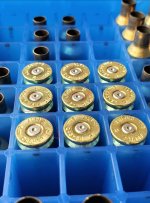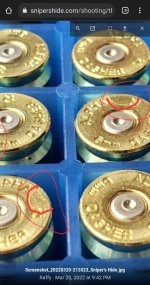This is the first time I've loaded for 6 Dasher and first experience with any of these components below.
For those shooting 6 Dasher, or just those more knowledgeable than myself, can you please educate me on the tell-tale pressure signs to look for?
I should know, but unfortunately don't...
I did 80 rounds of barrel break in using the below load
Load Data
I've never been shown cratering in person before and I don't know if this is how it is supposed to look.
I didn't feel like there was anything else abnormal with the operation of the rifle during all 80 rounds.
What do these pictures tell me and what charge and velocity "should" I be targeting with Varget and these components?


For those shooting 6 Dasher, or just those more knowledgeable than myself, can you please educate me on the tell-tale pressure signs to look for?
I should know, but unfortunately don't...
I did 80 rounds of barrel break in using the below load
Load Data
- 32.6gr Varget
- CCI 450
- 107gr SMKs
- Alpha Dasher OCD Brass
- 0.005 Jump
- MV 2915
- SD 7
- Lone Peak Fuzion
I've never been shown cratering in person before and I don't know if this is how it is supposed to look.
I didn't feel like there was anything else abnormal with the operation of the rifle during all 80 rounds.
What do these pictures tell me and what charge and velocity "should" I be targeting with Varget and these components?



